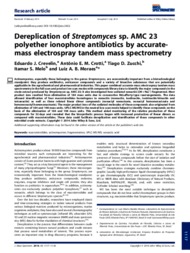Dereplication of Streptomyces sp. AMC 23 polyether ionophore antibiotics by accurate-mass electrospray tandem mass spectrometry.
Dereplication of Streptomyces sp. AMC 23 polyether ionophore antibiotics by accurate-mass electrospray tandem mass spectrometry.
Author(s): CREVELIN, E. J.; CROTTI, A. E. M.; ZUCCHI, T. D.; MELO, I. S. de; MORAES, L. A. B.
Summary: Abstracts: Actinomycetes, especially those belonging to the genus Streptomyces, are economically important from a biotechnological standpoint: they produce antibiotics, anticancer compounds and a variety of bioactive substances that are potentially applicable in the agrochemical and pharmaceutical industries. This paper combined accurate-mass electrospray tandem mass spectrometry in the full scan and product ion scan modes with compounds library data to identify the major compounds in the crude extract produced by Streptomyces sp. AMC 23; it also investigated how sodiated nonactin ([M + Na]+) fragmented. Most product ions resulted from elimination of 184 mass units due to consecutive McLafferty-type rearrangements. The data allowed identification of four macrotetrolides homologous to nonactin (monactin, isodinactin, isotrinactin/trinactin and tetranactin) as well as three related linear dimer compounds (nonactyl nonactoate, nonactyl homononactoate and homononactyl homononactoate). The major product ions of the sodiated molecules of these compounds also originated from elimination of 184 and 198 mass units. UPLC-MS/MS in the neutral loss scan mode helped to identify these compounds on the basis of the elimination of 184 and 198 mass units. This method aided monitoring of the relative production of these compounds for 32 days and revealed that the biosynthetic process began with increased production of linear dimers as compared with macrotetrolides. These data could facilitate dereplication and identification of these compounds in other microbial crude extracts.
Publication year: 2014
Types of publication: Journal article
Unit: Embrapa Environment
Observation
Some of Embrapa's publications are published as ePub files. To read them, use or download one of the following free software options to your computer or mobile device. Android: Google Play Books; IOS: iBooks; Windows and Linux: Calibre.
Access other publications
Access the Agricultural Research Database (BDPA) to consult Embrapa's full library collection and records.
Visit Embrapa Bookstore to purchase books and other publications sold by Embrapa.

